Effectiveness of Profile Injecting Attacks Against Recommender Systems
VerifiedAdded on 2021/06/17
|11
|2236
|293
Report
AI Summary
This report investigates the effectiveness of profile injecting attacks against recommender systems. It begins with an introduction outlining the background, aims, objectives, research questions, problem statement, and rationale, followed by a chapter on literature review that covers the overview of recommender systems, an analysis of profile injecting attacks, and the effectiveness of such attacks. The research methodology chapter details the research philosophy, approach, design, and data collection and analysis techniques. The study explores the vulnerability of collaborative filtering systems to malicious profiles, which are inserted to manipulate recommendations. The report analyzes the challenges involved in detecting and mitigating these attacks, and it proposes potential solutions. The report also examines the importance of identifying and responding to attacks to minimize their impact on the system. The report aims to provide a comprehensive understanding of profile injecting attacks and their implications for recommender systems, with the goal of enhancing their security and reliability.
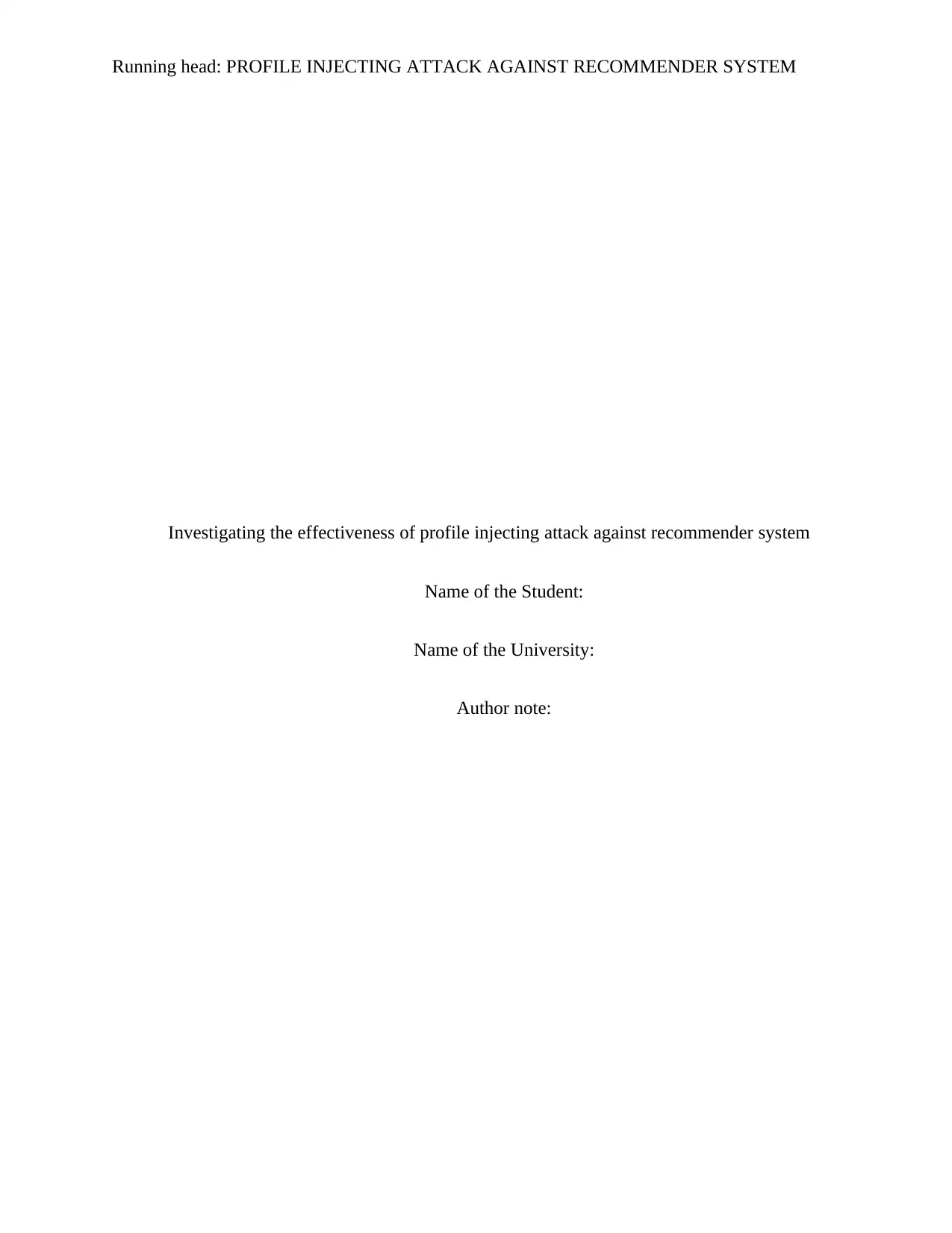
Running head: PROFILE INJECTING ATTACK AGAINST RECOMMENDER SYSTEM
Investigating the effectiveness of profile injecting attack against recommender system
Name of the Student:
Name of the University:
Author note:
Investigating the effectiveness of profile injecting attack against recommender system
Name of the Student:
Name of the University:
Author note:
Paraphrase This Document
Need a fresh take? Get an instant paraphrase of this document with our AI Paraphraser
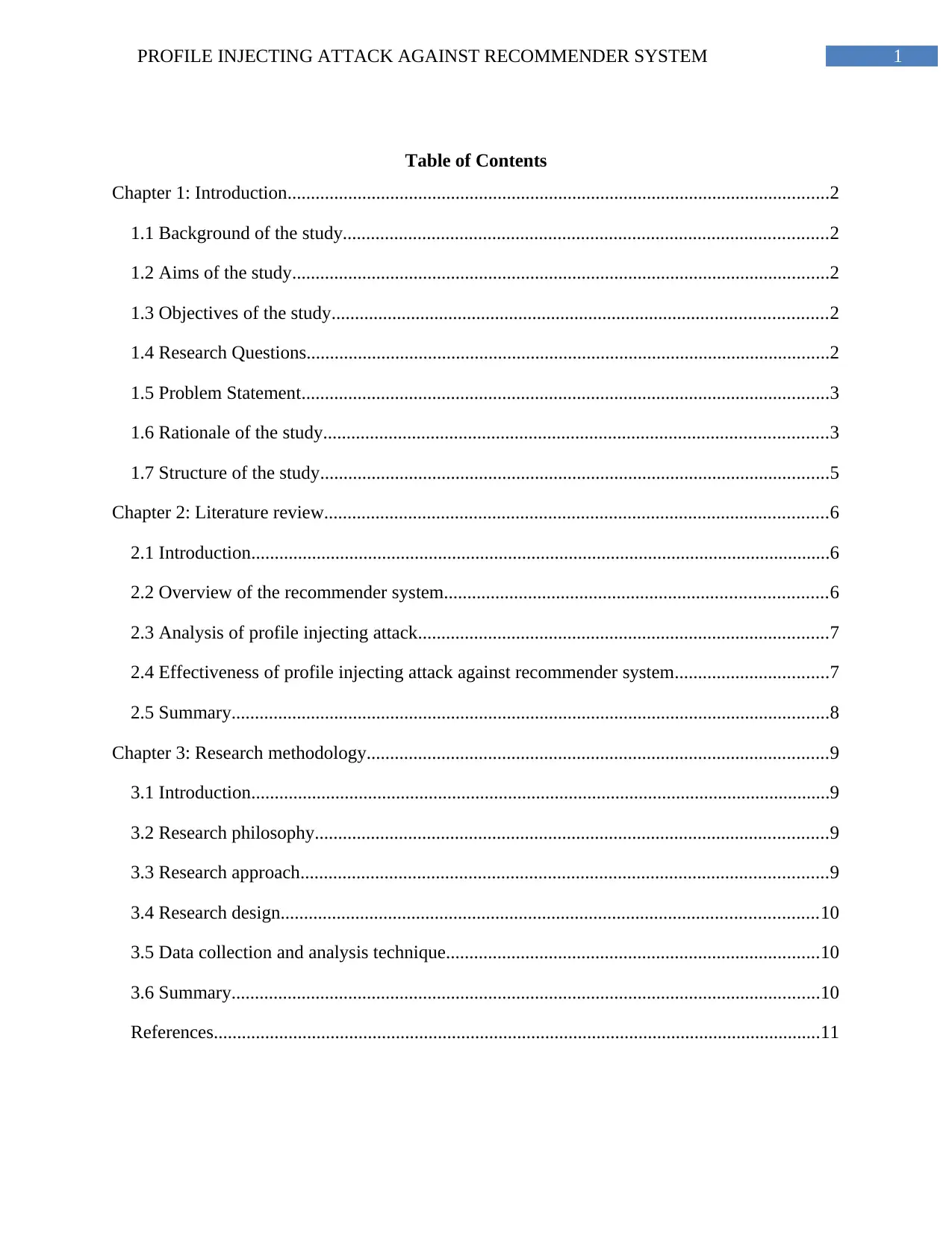
1PROFILE INJECTING ATTACK AGAINST RECOMMENDER SYSTEM
Table of Contents
Chapter 1: Introduction....................................................................................................................2
1.1 Background of the study........................................................................................................2
1.2 Aims of the study...................................................................................................................2
1.3 Objectives of the study..........................................................................................................2
1.4 Research Questions................................................................................................................2
1.5 Problem Statement.................................................................................................................3
1.6 Rationale of the study............................................................................................................3
1.7 Structure of the study.............................................................................................................5
Chapter 2: Literature review............................................................................................................6
2.1 Introduction............................................................................................................................6
2.2 Overview of the recommender system..................................................................................6
2.3 Analysis of profile injecting attack........................................................................................7
2.4 Effectiveness of profile injecting attack against recommender system.................................7
2.5 Summary................................................................................................................................8
Chapter 3: Research methodology...................................................................................................9
3.1 Introduction............................................................................................................................9
3.2 Research philosophy..............................................................................................................9
3.3 Research approach.................................................................................................................9
3.4 Research design...................................................................................................................10
3.5 Data collection and analysis technique................................................................................10
3.6 Summary..............................................................................................................................10
References..................................................................................................................................11
Table of Contents
Chapter 1: Introduction....................................................................................................................2
1.1 Background of the study........................................................................................................2
1.2 Aims of the study...................................................................................................................2
1.3 Objectives of the study..........................................................................................................2
1.4 Research Questions................................................................................................................2
1.5 Problem Statement.................................................................................................................3
1.6 Rationale of the study............................................................................................................3
1.7 Structure of the study.............................................................................................................5
Chapter 2: Literature review............................................................................................................6
2.1 Introduction............................................................................................................................6
2.2 Overview of the recommender system..................................................................................6
2.3 Analysis of profile injecting attack........................................................................................7
2.4 Effectiveness of profile injecting attack against recommender system.................................7
2.5 Summary................................................................................................................................8
Chapter 3: Research methodology...................................................................................................9
3.1 Introduction............................................................................................................................9
3.2 Research philosophy..............................................................................................................9
3.3 Research approach.................................................................................................................9
3.4 Research design...................................................................................................................10
3.5 Data collection and analysis technique................................................................................10
3.6 Summary..............................................................................................................................10
References..................................................................................................................................11

2PROFILE INJECTING ATTACK AGAINST RECOMMENDER SYSTEM
Chapter 1: Introduction
1.1 Background of the study
From starting of the web services on the internet has been expanding at rapid rate.
However, retrieval of information is considered as a significant problem (Gunes et al. 2014). A
recommender system is known as a system suggesting items to different user where it might get
interest. It is necessary for people consulting with different individuals and asks regarding their
experiences during making any selections.
1.2 Aims of the study
The aim of the study will be analysing the effectiveness of profile injecting attack against
recommender system such as Netflix, Amazon or any type of published recommender system.
1.3 Objectives of the study
To critically analyse the effectiveness of profile injecting attack against
recommender system
To evaluate the process of profile injecting attack
To find out the challenges involved in the system
To recommend specific solutions to overcome the issues
1.4 Research Questions
How profile-injecting attack against recommender system is effective?
What is the process of profile injecting attack?
What are the challenges involved in the system?
What are the solutions for overcoming the issues?
Chapter 1: Introduction
1.1 Background of the study
From starting of the web services on the internet has been expanding at rapid rate.
However, retrieval of information is considered as a significant problem (Gunes et al. 2014). A
recommender system is known as a system suggesting items to different user where it might get
interest. It is necessary for people consulting with different individuals and asks regarding their
experiences during making any selections.
1.2 Aims of the study
The aim of the study will be analysing the effectiveness of profile injecting attack against
recommender system such as Netflix, Amazon or any type of published recommender system.
1.3 Objectives of the study
To critically analyse the effectiveness of profile injecting attack against
recommender system
To evaluate the process of profile injecting attack
To find out the challenges involved in the system
To recommend specific solutions to overcome the issues
1.4 Research Questions
How profile-injecting attack against recommender system is effective?
What is the process of profile injecting attack?
What are the challenges involved in the system?
What are the solutions for overcoming the issues?
⊘ This is a preview!⊘
Do you want full access?
Subscribe today to unlock all pages.

Trusted by 1+ million students worldwide

3PROFILE INJECTING ATTACK AGAINST RECOMMENDER SYSTEM
1.5 Problem Statement
Burke, O’Mahony and Hurley (2015) stated that sseveral websites make attempt-helping
users through incorporating a recommender system. In the other hand, content-based filtering
system as well as collaborative filtering is generally applied for predicting the recommendations.
Apart from this, collaborative filtering is considered as one of the most general approaches in
order to design e-commerce recommended system. However, the most of the robust systems are
not affected by the profile injection attacks. In addition, any type of collaborative systems is able
to do that.
1.6 Rationale of the study
E-commerce recommender systems are usually considered as vulnerable to distinctive
types of profile-injection attacks where profiles of fake users are inserted into the system in order
to influence recommendation composed by the users. The attack-profiles are usually considered
as the outliers in the user rated dataset (Yang et al. 2016). It is difficult for designing a particular
system, which cannot be attached. In the past, studying robust recommendations are studied to
recognize as well as defeating attacks. In this perspective, it becomes important to analyse the
effectiveness of profile injecting attack against recommender systems.
1.7 Structure of the study
The study consists of introduction, literature review and research methodology.
Introduction chapter consists of research aims, objectives and research questions. In addition,
background, problem statement and research rationale are described in this chapter. On the other
hand, literature review includes overview of the concept, theories, models and impact. Third
chapter, research methodology covers research philosophy, research approach and research
design.
1.5 Problem Statement
Burke, O’Mahony and Hurley (2015) stated that sseveral websites make attempt-helping
users through incorporating a recommender system. In the other hand, content-based filtering
system as well as collaborative filtering is generally applied for predicting the recommendations.
Apart from this, collaborative filtering is considered as one of the most general approaches in
order to design e-commerce recommended system. However, the most of the robust systems are
not affected by the profile injection attacks. In addition, any type of collaborative systems is able
to do that.
1.6 Rationale of the study
E-commerce recommender systems are usually considered as vulnerable to distinctive
types of profile-injection attacks where profiles of fake users are inserted into the system in order
to influence recommendation composed by the users. The attack-profiles are usually considered
as the outliers in the user rated dataset (Yang et al. 2016). It is difficult for designing a particular
system, which cannot be attached. In the past, studying robust recommendations are studied to
recognize as well as defeating attacks. In this perspective, it becomes important to analyse the
effectiveness of profile injecting attack against recommender systems.
1.7 Structure of the study
The study consists of introduction, literature review and research methodology.
Introduction chapter consists of research aims, objectives and research questions. In addition,
background, problem statement and research rationale are described in this chapter. On the other
hand, literature review includes overview of the concept, theories, models and impact. Third
chapter, research methodology covers research philosophy, research approach and research
design.
Paraphrase This Document
Need a fresh take? Get an instant paraphrase of this document with our AI Paraphraser
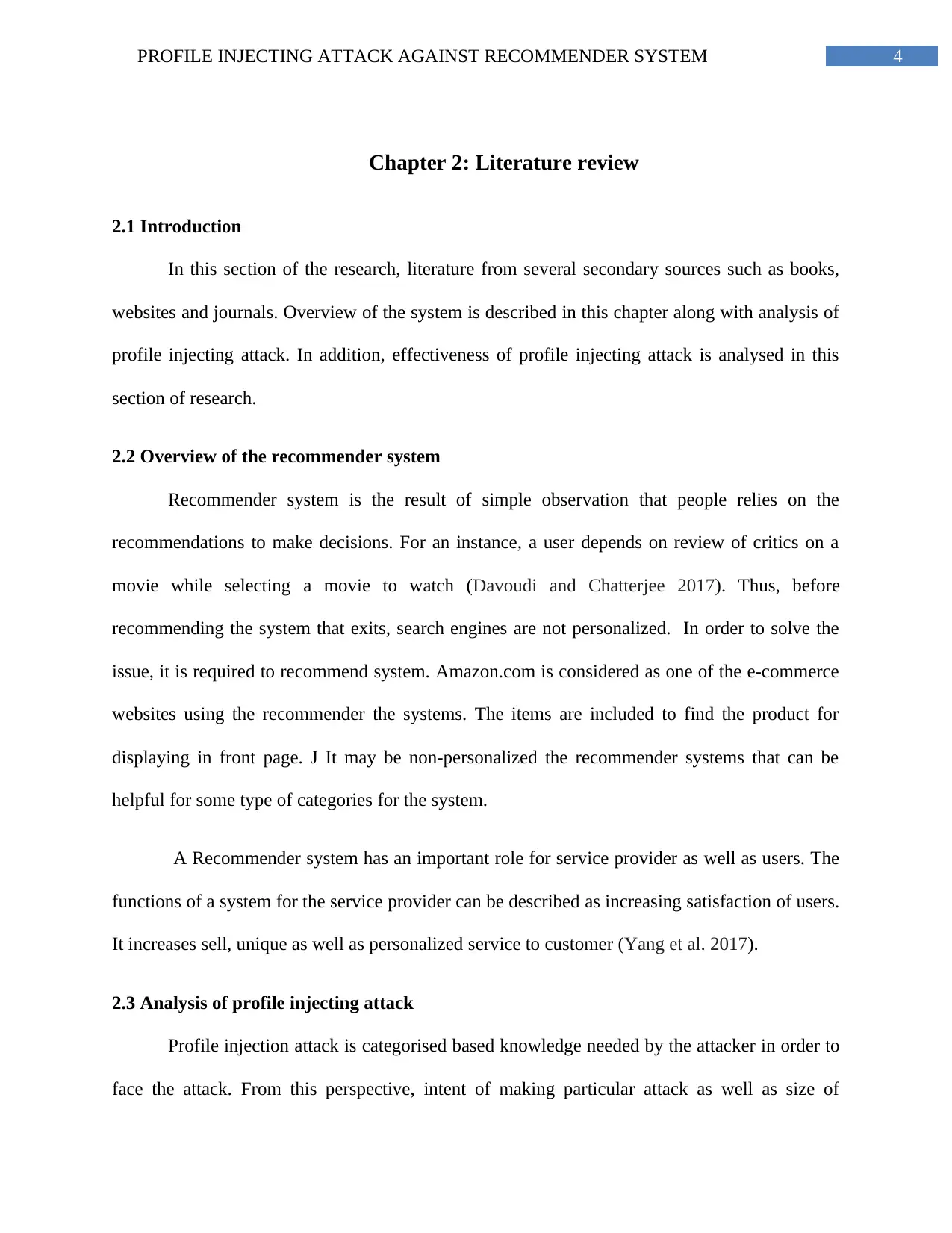
4PROFILE INJECTING ATTACK AGAINST RECOMMENDER SYSTEM
Chapter 2: Literature review
2.1 Introduction
In this section of the research, literature from several secondary sources such as books,
websites and journals. Overview of the system is described in this chapter along with analysis of
profile injecting attack. In addition, effectiveness of profile injecting attack is analysed in this
section of research.
2.2 Overview of the recommender system
Recommender system is the result of simple observation that people relies on the
recommendations to make decisions. For an instance, a user depends on review of critics on a
movie while selecting a movie to watch (Davoudi and Chatterjee 2017). Thus, before
recommending the system that exits, search engines are not personalized. In order to solve the
issue, it is required to recommend system. Amazon.com is considered as one of the e-commerce
websites using the recommender the systems. The items are included to find the product for
displaying in front page. J It may be non-personalized the recommender systems that can be
helpful for some type of categories for the system.
A Recommender system has an important role for service provider as well as users. The
functions of a system for the service provider can be described as increasing satisfaction of users.
It increases sell, unique as well as personalized service to customer (Yang et al. 2017).
2.3 Analysis of profile injecting attack
Profile injection attack is categorised based knowledge needed by the attacker in order to
face the attack. From this perspective, intent of making particular attack as well as size of
Chapter 2: Literature review
2.1 Introduction
In this section of the research, literature from several secondary sources such as books,
websites and journals. Overview of the system is described in this chapter along with analysis of
profile injecting attack. In addition, effectiveness of profile injecting attack is analysed in this
section of research.
2.2 Overview of the recommender system
Recommender system is the result of simple observation that people relies on the
recommendations to make decisions. For an instance, a user depends on review of critics on a
movie while selecting a movie to watch (Davoudi and Chatterjee 2017). Thus, before
recommending the system that exits, search engines are not personalized. In order to solve the
issue, it is required to recommend system. Amazon.com is considered as one of the e-commerce
websites using the recommender the systems. The items are included to find the product for
displaying in front page. J It may be non-personalized the recommender systems that can be
helpful for some type of categories for the system.
A Recommender system has an important role for service provider as well as users. The
functions of a system for the service provider can be described as increasing satisfaction of users.
It increases sell, unique as well as personalized service to customer (Yang et al. 2017).
2.3 Analysis of profile injecting attack
Profile injection attack is categorised based knowledge needed by the attacker in order to
face the attack. From this perspective, intent of making particular attack as well as size of
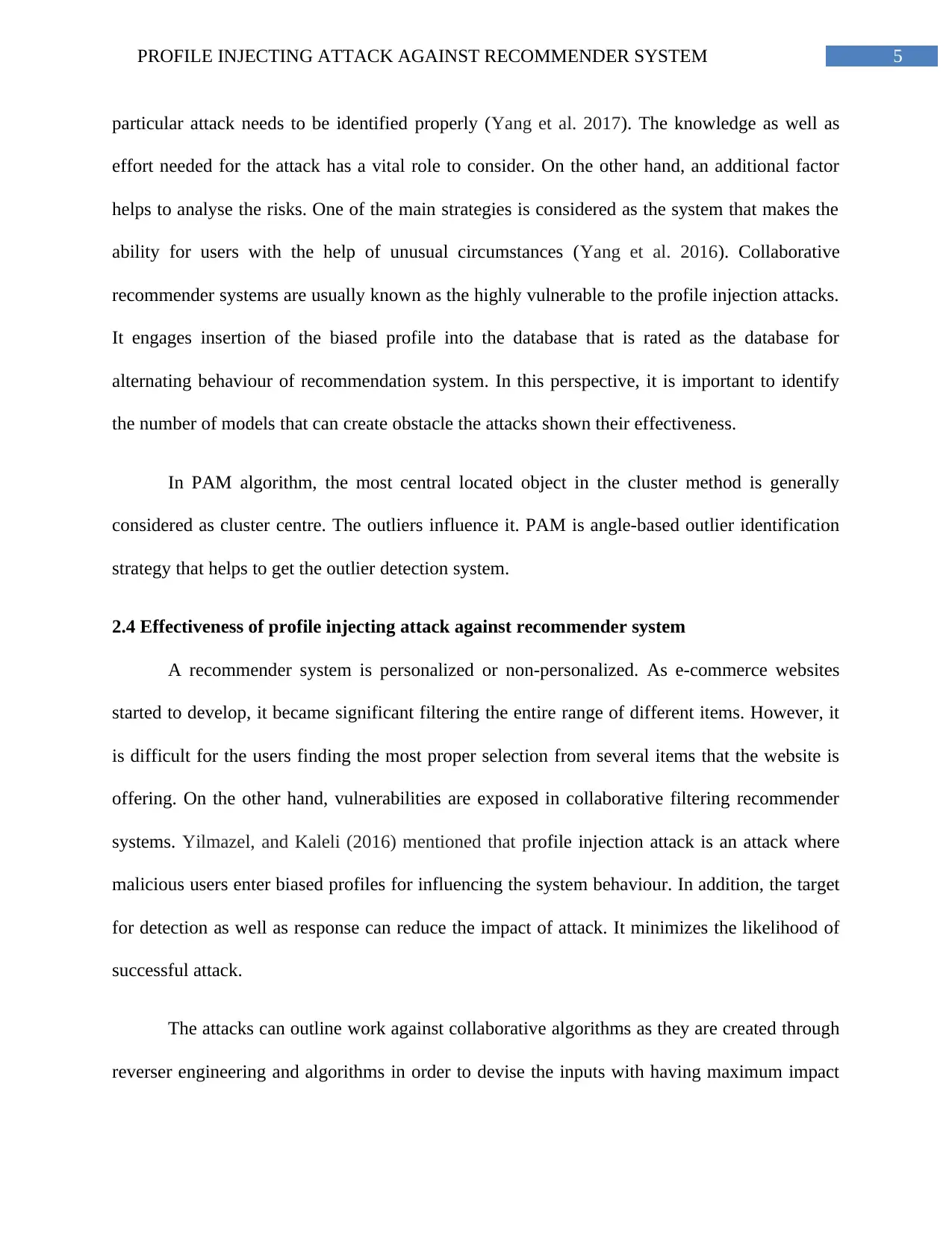
5PROFILE INJECTING ATTACK AGAINST RECOMMENDER SYSTEM
particular attack needs to be identified properly (Yang et al. 2017). The knowledge as well as
effort needed for the attack has a vital role to consider. On the other hand, an additional factor
helps to analyse the risks. One of the main strategies is considered as the system that makes the
ability for users with the help of unusual circumstances (Yang et al. 2016). Collaborative
recommender systems are usually known as the highly vulnerable to the profile injection attacks.
It engages insertion of the biased profile into the database that is rated as the database for
alternating behaviour of recommendation system. In this perspective, it is important to identify
the number of models that can create obstacle the attacks shown their effectiveness.
In PAM algorithm, the most central located object in the cluster method is generally
considered as cluster centre. The outliers influence it. PAM is angle-based outlier identification
strategy that helps to get the outlier detection system.
2.4 Effectiveness of profile injecting attack against recommender system
A recommender system is personalized or non-personalized. As e-commerce websites
started to develop, it became significant filtering the entire range of different items. However, it
is difficult for the users finding the most proper selection from several items that the website is
offering. On the other hand, vulnerabilities are exposed in collaborative filtering recommender
systems. Yilmazel, and Kaleli (2016) mentioned that profile injection attack is an attack where
malicious users enter biased profiles for influencing the system behaviour. In addition, the target
for detection as well as response can reduce the impact of attack. It minimizes the likelihood of
successful attack.
The attacks can outline work against collaborative algorithms as they are created through
reverser engineering and algorithms in order to devise the inputs with having maximum impact
particular attack needs to be identified properly (Yang et al. 2017). The knowledge as well as
effort needed for the attack has a vital role to consider. On the other hand, an additional factor
helps to analyse the risks. One of the main strategies is considered as the system that makes the
ability for users with the help of unusual circumstances (Yang et al. 2016). Collaborative
recommender systems are usually known as the highly vulnerable to the profile injection attacks.
It engages insertion of the biased profile into the database that is rated as the database for
alternating behaviour of recommendation system. In this perspective, it is important to identify
the number of models that can create obstacle the attacks shown their effectiveness.
In PAM algorithm, the most central located object in the cluster method is generally
considered as cluster centre. The outliers influence it. PAM is angle-based outlier identification
strategy that helps to get the outlier detection system.
2.4 Effectiveness of profile injecting attack against recommender system
A recommender system is personalized or non-personalized. As e-commerce websites
started to develop, it became significant filtering the entire range of different items. However, it
is difficult for the users finding the most proper selection from several items that the website is
offering. On the other hand, vulnerabilities are exposed in collaborative filtering recommender
systems. Yilmazel, and Kaleli (2016) mentioned that profile injection attack is an attack where
malicious users enter biased profiles for influencing the system behaviour. In addition, the target
for detection as well as response can reduce the impact of attack. It minimizes the likelihood of
successful attack.
The attacks can outline work against collaborative algorithms as they are created through
reverser engineering and algorithms in order to devise the inputs with having maximum impact
⊘ This is a preview!⊘
Do you want full access?
Subscribe today to unlock all pages.

Trusted by 1+ million students worldwide
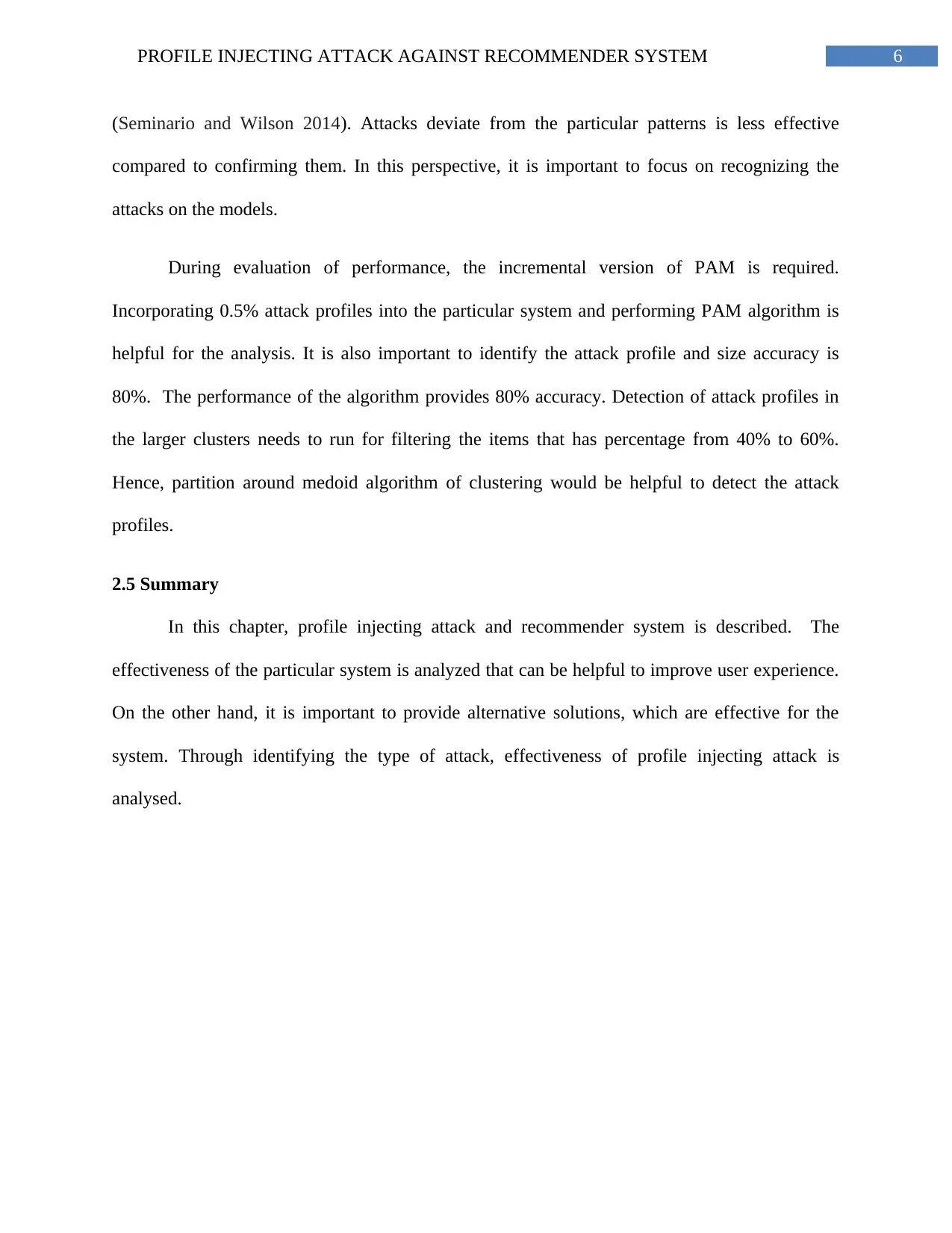
6PROFILE INJECTING ATTACK AGAINST RECOMMENDER SYSTEM
(Seminario and Wilson 2014). Attacks deviate from the particular patterns is less effective
compared to confirming them. In this perspective, it is important to focus on recognizing the
attacks on the models.
During evaluation of performance, the incremental version of PAM is required.
Incorporating 0.5% attack profiles into the particular system and performing PAM algorithm is
helpful for the analysis. It is also important to identify the attack profile and size accuracy is
80%. The performance of the algorithm provides 80% accuracy. Detection of attack profiles in
the larger clusters needs to run for filtering the items that has percentage from 40% to 60%.
Hence, partition around medoid algorithm of clustering would be helpful to detect the attack
profiles.
2.5 Summary
In this chapter, profile injecting attack and recommender system is described. The
effectiveness of the particular system is analyzed that can be helpful to improve user experience.
On the other hand, it is important to provide alternative solutions, which are effective for the
system. Through identifying the type of attack, effectiveness of profile injecting attack is
analysed.
(Seminario and Wilson 2014). Attacks deviate from the particular patterns is less effective
compared to confirming them. In this perspective, it is important to focus on recognizing the
attacks on the models.
During evaluation of performance, the incremental version of PAM is required.
Incorporating 0.5% attack profiles into the particular system and performing PAM algorithm is
helpful for the analysis. It is also important to identify the attack profile and size accuracy is
80%. The performance of the algorithm provides 80% accuracy. Detection of attack profiles in
the larger clusters needs to run for filtering the items that has percentage from 40% to 60%.
Hence, partition around medoid algorithm of clustering would be helpful to detect the attack
profiles.
2.5 Summary
In this chapter, profile injecting attack and recommender system is described. The
effectiveness of the particular system is analyzed that can be helpful to improve user experience.
On the other hand, it is important to provide alternative solutions, which are effective for the
system. Through identifying the type of attack, effectiveness of profile injecting attack is
analysed.
Paraphrase This Document
Need a fresh take? Get an instant paraphrase of this document with our AI Paraphraser

7PROFILE INJECTING ATTACK AGAINST RECOMMENDER SYSTEM
Chapter 3: Research methodology
3.1 Introduction
In this chapter, methodological tools are selected that will be helpful to conduct the
research in proper way. Research philosophy, design and approach are described in this part of
study. On the other hand, data collection and analysis technique are discussed along with
sampling technique.
3.2 Research philosophy
Research philosophy assists in assuming the procedure of research undertaken by the
researcher during conduction of the study (Mackey and Gass 2015). The procedure of carrying
out the research is varied for evaluation of the research topic. Hence, selection of research needs
to be effective and properly aligned. There are different types of research philosophies taken for
the research like positivism, realism as well as interpretivism. In the current research, positivism
philosophy will be selected for analyzing the effectiveness of profile injecting attack against
recommender system. It helps to understand the hidden facts and information for the research in
a scientific way.
3.3 Research approach
Vaioleti (2016) mentioned that research approach for a study is required so that the
format of the research will be revealed. Inductive and deductive approach is the types of
research approaches in order to complete the research successfully. Deductive approach deals
with formulation of hypothesis that is based on the existing theory that will be selected in the
research.
Chapter 3: Research methodology
3.1 Introduction
In this chapter, methodological tools are selected that will be helpful to conduct the
research in proper way. Research philosophy, design and approach are described in this part of
study. On the other hand, data collection and analysis technique are discussed along with
sampling technique.
3.2 Research philosophy
Research philosophy assists in assuming the procedure of research undertaken by the
researcher during conduction of the study (Mackey and Gass 2015). The procedure of carrying
out the research is varied for evaluation of the research topic. Hence, selection of research needs
to be effective and properly aligned. There are different types of research philosophies taken for
the research like positivism, realism as well as interpretivism. In the current research, positivism
philosophy will be selected for analyzing the effectiveness of profile injecting attack against
recommender system. It helps to understand the hidden facts and information for the research in
a scientific way.
3.3 Research approach
Vaioleti (2016) mentioned that research approach for a study is required so that the
format of the research will be revealed. Inductive and deductive approach is the types of
research approaches in order to complete the research successfully. Deductive approach deals
with formulation of hypothesis that is based on the existing theory that will be selected in the
research.
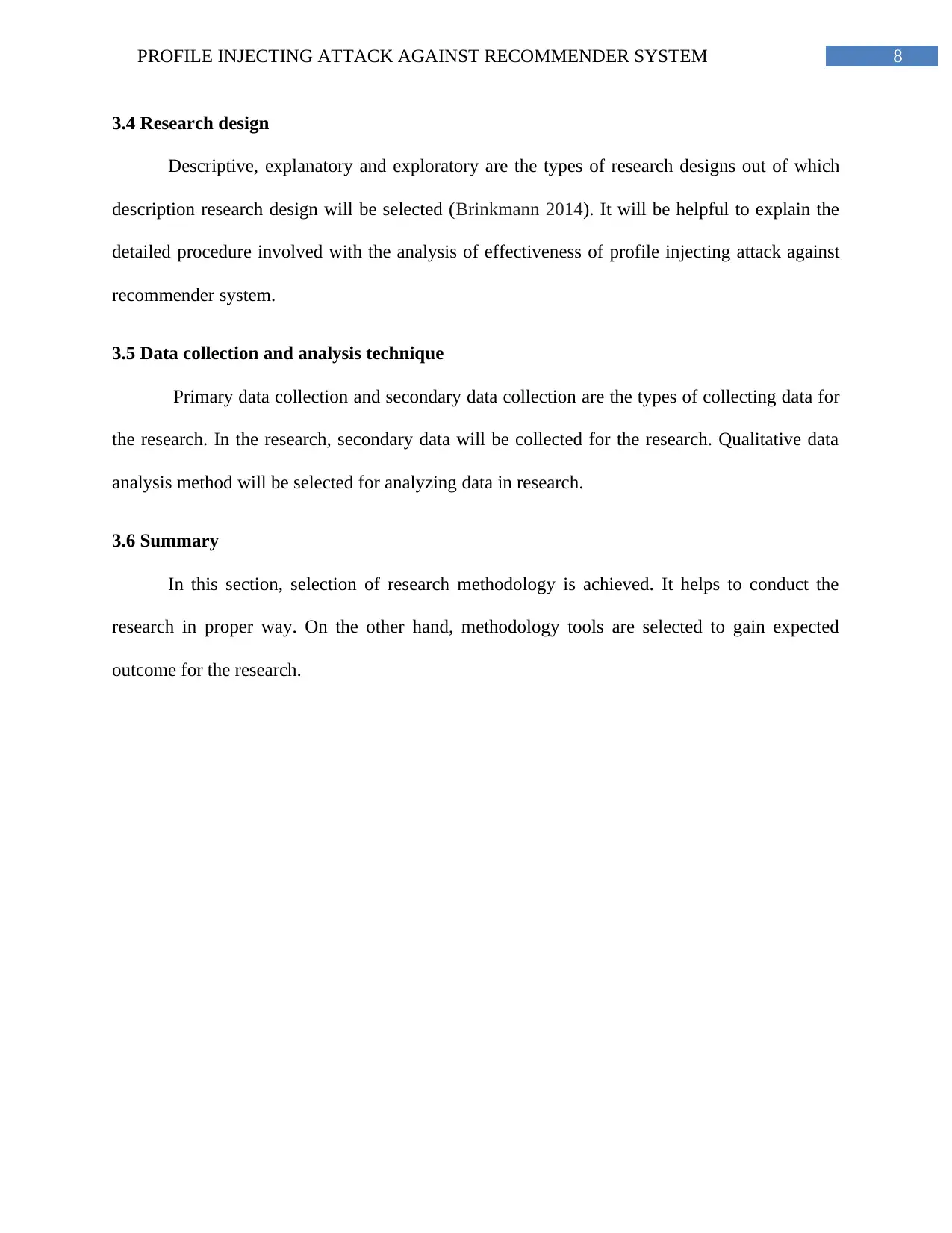
8PROFILE INJECTING ATTACK AGAINST RECOMMENDER SYSTEM
3.4 Research design
Descriptive, explanatory and exploratory are the types of research designs out of which
description research design will be selected (Brinkmann 2014). It will be helpful to explain the
detailed procedure involved with the analysis of effectiveness of profile injecting attack against
recommender system.
3.5 Data collection and analysis technique
Primary data collection and secondary data collection are the types of collecting data for
the research. In the research, secondary data will be collected for the research. Qualitative data
analysis method will be selected for analyzing data in research.
3.6 Summary
In this section, selection of research methodology is achieved. It helps to conduct the
research in proper way. On the other hand, methodology tools are selected to gain expected
outcome for the research.
3.4 Research design
Descriptive, explanatory and exploratory are the types of research designs out of which
description research design will be selected (Brinkmann 2014). It will be helpful to explain the
detailed procedure involved with the analysis of effectiveness of profile injecting attack against
recommender system.
3.5 Data collection and analysis technique
Primary data collection and secondary data collection are the types of collecting data for
the research. In the research, secondary data will be collected for the research. Qualitative data
analysis method will be selected for analyzing data in research.
3.6 Summary
In this section, selection of research methodology is achieved. It helps to conduct the
research in proper way. On the other hand, methodology tools are selected to gain expected
outcome for the research.
⊘ This is a preview!⊘
Do you want full access?
Subscribe today to unlock all pages.

Trusted by 1+ million students worldwide

9PROFILE INJECTING ATTACK AGAINST RECOMMENDER SYSTEM
References
Brinkmann, S., 2014. Interview. In Encyclopedia of critical psychology (pp. 1008-1010).
Springer New York.
Burke, R., O’Mahony, M.P. and Hurley, N.J., 2015. Robust collaborative recommendation.
In Recommender systems handbook (pp. 961-995). Springer, Boston, MA.
Davoudi, A. and Chatterjee, M., 2017, December. Detection of profile injection attacks in social
recommender systems using outlier analysis. In Big Data (Big Data), 2017 IEEE International
Conference on (pp. 2714-2719). IEEE.
Gunes, I., Kaleli, C., Bilge, A. and Polat, H., 2014. Shilling attacks against recommender
systems: a comprehensive survey. Artificial Intelligence Review, 42(4), pp.767-799.
Mackey, A. and Gass, S.M., 2015. Second language research: Methodology and design.
Routledge.
Seminario, C.E. and Wilson, D.C., 2014, October. Attacking item-based recommender systems
with power items. In Proceedings of the 8th ACM Conference on Recommender systems (pp. 57-
64). ACM.
Vaioleti, T.M., 2016. Talanoa research methodology: A developing position on Pacific
research. Waikato Journal of Education, 12(1).
Yang, Z., Xu, L., Cai, Z. and Xu, Z., 2016. Re-scale AdaBoost for attack detection in
collaborative filtering recommender systems. Knowledge-Based Systems, 100, pp.74-88.
References
Brinkmann, S., 2014. Interview. In Encyclopedia of critical psychology (pp. 1008-1010).
Springer New York.
Burke, R., O’Mahony, M.P. and Hurley, N.J., 2015. Robust collaborative recommendation.
In Recommender systems handbook (pp. 961-995). Springer, Boston, MA.
Davoudi, A. and Chatterjee, M., 2017, December. Detection of profile injection attacks in social
recommender systems using outlier analysis. In Big Data (Big Data), 2017 IEEE International
Conference on (pp. 2714-2719). IEEE.
Gunes, I., Kaleli, C., Bilge, A. and Polat, H., 2014. Shilling attacks against recommender
systems: a comprehensive survey. Artificial Intelligence Review, 42(4), pp.767-799.
Mackey, A. and Gass, S.M., 2015. Second language research: Methodology and design.
Routledge.
Seminario, C.E. and Wilson, D.C., 2014, October. Attacking item-based recommender systems
with power items. In Proceedings of the 8th ACM Conference on Recommender systems (pp. 57-
64). ACM.
Vaioleti, T.M., 2016. Talanoa research methodology: A developing position on Pacific
research. Waikato Journal of Education, 12(1).
Yang, Z., Xu, L., Cai, Z. and Xu, Z., 2016. Re-scale AdaBoost for attack detection in
collaborative filtering recommender systems. Knowledge-Based Systems, 100, pp.74-88.
Paraphrase This Document
Need a fresh take? Get an instant paraphrase of this document with our AI Paraphraser

10PROFILE INJECTING ATTACK AGAINST RECOMMENDER SYSTEM
Yang, L., Huang, W. and Niu, X., 2017. Defending shilling attacks in recommender systems
using soft co-clustering. IET Information Security, 11(6), pp.319-325.
Yang, Z., Cai, Z. and Yang, Y., 2017. Spotting anomalous ratings for rating systems by
analyzing target users and items. Neurocomputing, 240, pp.25-46.
Yang, Z., Cai, Z. and Guan, X., 2016. Estimating user behavior toward detecting anomalous
ratings in rating systems. Knowledge-Based Systems, 111, pp.144-158.
Yilmazel, B.Y. and Kaleli, C., 2016. Robustness analysis of arbitrarily distributed data-based
recommendation methods. Expert Systems with Applications, 44, pp.217-229.
Yang, L., Huang, W. and Niu, X., 2017. Defending shilling attacks in recommender systems
using soft co-clustering. IET Information Security, 11(6), pp.319-325.
Yang, Z., Cai, Z. and Yang, Y., 2017. Spotting anomalous ratings for rating systems by
analyzing target users and items. Neurocomputing, 240, pp.25-46.
Yang, Z., Cai, Z. and Guan, X., 2016. Estimating user behavior toward detecting anomalous
ratings in rating systems. Knowledge-Based Systems, 111, pp.144-158.
Yilmazel, B.Y. and Kaleli, C., 2016. Robustness analysis of arbitrarily distributed data-based
recommendation methods. Expert Systems with Applications, 44, pp.217-229.
1 out of 11
Related Documents
Your All-in-One AI-Powered Toolkit for Academic Success.
+13062052269
info@desklib.com
Available 24*7 on WhatsApp / Email
![[object Object]](/_next/static/media/star-bottom.7253800d.svg)
Unlock your academic potential
Copyright © 2020–2025 A2Z Services. All Rights Reserved. Developed and managed by ZUCOL.





